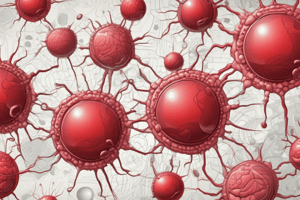Podcast
Questions and Answers
RBC are formally called ______ cells.
RBC are formally called ______ cells.
erythrocytes
Nucleated precursors in the bone marrow are called ______.
Nucleated precursors in the bone marrow are called ______.
erythroblasts
The “mother cell” is also known as a ______.
The “mother cell” is also known as a ______.
Pronormoblast
The last stage capable of mitosis is called ______.
The last stage capable of mitosis is called ______.
Erythrocytes are characterized by a ______ disc shape.
Erythrocytes are characterized by a ______ disc shape.
Polychromatic erythrocytes are also called ______ when stained with a vital stain.
Polychromatic erythrocytes are also called ______ when stained with a vital stain.
Flashcards are hidden until you start studying
Study Notes
Erythrocyte Development
- RBCs are formally called erythrocytes
- Nucleated precursors in the bone marrow are called erythroblasts
Pronormoblast/Rubriblast/Proerythroblast
- Largest of the erythroid precursors
- Nucleus:
- N:C ratio: 4:1
- Chromatin: fine and dark staining
- Nucleoli: 1-2
- Cytoplasm:
- Heterogeneous
- Dark blue (distinctly basophilic)
- No granules
Prorubicyte/Basophilic Normoblast (Erythroblast)
- Nucleus:
- N:C ratio: 4:1
- Chromatin: partially clumped, wheel with broad spokes
- Nucleoli: ABSENT
- Cytoplasm:
- Deeply basophilic
- No granules
Rubicyte/Polychromatic Normoblast (Erythroblast)
- "Dawn of hemoglobinization"
- Last stage capable of mitosis
- Nucleus:
- N:C ratio: 1:1
- Chromatin: increasingly clumped
- Nucleoli: ABSENT
- Cytoplasm:
- Mixtures of red-staining hemoglobin with blue RNA in varying shades of gray
- Pink coloration mixed with basophilia → Muddy, light gray appearance
Metarubicyte/Orthochromic Normoblast (Erythroblast)
- Nucleated RBC
- Mitosis no longer possible
- Nucleus:
- N:C ratio: LOW
- Chromatin: pyknotic (dense or compact)
- Nucleoli: ABSENT
- Cytoplasm:
- Acidophilic (reddish pink) cytoplasm
- Salmon-pink color
Polychromatic Erythrocyte
- Called reticulocytes when stained with a vital stain
- No nucleus
- Polychromatophilic due to retention of RNA
- Synthesizing hemoglobin for 2-3 days in the marrow and for 1 day in the blood
- Seen in Wright's stain as large bluish-red cells, Polychromatophilic macrocytes
Erythrocyte
- No nucleus
- Biconcave disc
- Salmon pink-staining cell with a central pale area
- Area of central pallor of 1-3 um (1/3 of the cell)
- Circulate for about 120 days
Studying That Suits You
Use AI to generate personalized quizzes and flashcards to suit your learning preferences.




